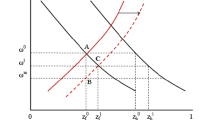Abstract
Traditionally, most attempts to explain the specialization patterns of countries in international trade have focused on supply conditions. According to the standard neoclassical theory of international trade, countries ought to specialize in areas of production that make intensive use of factors of production with which the country is relatively well equipped. However, empirical research has shown that the explanatory power of this type of theory is rather limited (Bowen et al., 1987).
Access this chapter
Tax calculation will be finalised at checkout
Purchases are for personal use only
Preview
Unable to display preview. Download preview PDF.
Similar content being viewed by others
References
Andersen, E.S., B. Dalum and G. Villumsen, 1881, International Specialization and the Home Market, Aalborg University Press, Aalborg.
Balassa, B., 1965, “Trade Liberalization and ‘Revealed’ Comparative Advantage”, The Manchester School, 33:99–123.
Bowen, H.P., E. Learner and L. Sveikauskas, 1987, “Multicountry, Multifactor Tests of the Factor Abundance Theory”, American Economic Review, 77:791–809.
Burenstam-Linder, S., 1961, An Essay on Trade and Transformation, Almquist & Wicksell, Uppsala.
Dahmén, E., 1970, Entrepreneurial Activity and the Development of Swedish Industry 1919–1939, American Economic Association Translation Series, Homewood.
De Bresson, C. and F. Amesse, 1991, “Networks of Innovators: A Review and Introduction to the Issue”, Research Policy, 20:363–379.
Dosi, G. and L. Soete, 1988, “Technical Change and International trade”, in Dosi, G. et al., (eds), Technical Change and Economic Theory, Pinter, London.
Fagerberg, J., 1992, “The ‘Home-Market Hypothesis’ Reexamined”, in Lundvall, B.Å., (ed.), National Systems of Innovation — Towards a Theory of Innovation and Interactive Learning, Pinter, London.
Hirschman, A. O., 1958, The Strategy of Economic Development, Yale University Press, New Haven, Conn.
Håkansson, H., 1987, Industrial Technological Development, Croom Helm, London.
List, F., 1959, Das Nationale System der politischen Ökonomie, Kyklos-Verlag, Basel.
Lundvall, B. Å., 1988, “Innovation as an Interactive Process — from User-Producer Interaction to the National System of Innovation”, in Dosi, G. et al., (eds.), Technical Change and Economic Theory, Pinter, London.
Lundvall, B.Å., 1992, “User-Producer Relationships, National System of Innovation and Internationalisation”, in Lundvall, B.Å., (ed.), National Systems of Innovation — Towards a Theory of Innovation and Interactive Learning, Pinter, London.
Perroux, F., 1956, “Note sur la Notion de Pôle de Croissance”, Economie Appliquée, 7:307–320.
Porter, M. E., 1990, The Competitive Advantage of Nations, MacMillan, London.
Schumpeter, J., 1934, The Theory of Economic Development, Harvard University Press, Cambridge, Mass.
Schumpeter, J., 1939, Business Cycles I-II, McGraw-Hill, New York.
Schumpeter, J., 1943, Capitalism, Socialism and Democracy, Harper, New York.
Author information
Authors and Affiliations
Editor information
Editors and Affiliations
Rights and permissions
Copyright information
© 1994 Springer-Verlag Berlin · Heidelberg
About this chapter
Cite this chapter
Fagerberg, J. (1994). Domestic Demand, Learning and Comparative Advantage. In: Johansson, B., Karlsson, C., Westin, L. (eds) Patterns of a Network Economy. Advances in Spatial and Network Economics. Springer, Berlin, Heidelberg. https://doi.org/10.1007/978-3-642-78898-7_8
Download citation
DOI: https://doi.org/10.1007/978-3-642-78898-7_8
Publisher Name: Springer, Berlin, Heidelberg
Print ISBN: 978-3-642-78900-7
Online ISBN: 978-3-642-78898-7
eBook Packages: Springer Book Archive




